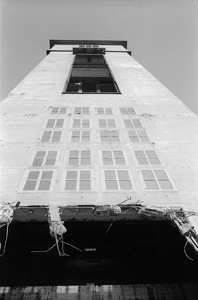The coal mines: Limburg’s ‘black gold’ > From working mine to closure
In the company book Oranje Nassau (1953) Nico Jesse illustrates the coal mining process in a continuous series of photos. The book was published on the occasion of the Oranje Nassau Mines’ 60th anniversary and represents them as a dynamic and well-oiled concern. Many photos were taken underground, featuring miners at work, engines in hewn mine galleries, loading and unloading stages, transport galleries and chain conveyors etc. But Jesse’s photos are not limited to the underground work; they also depict the management and the administration departments at the head office, power stations, the briquette factory, the boiler house, the cooling towers, the Ondergrondse Vakschool (Underground Technical School) and the miners’ lodgings.
Nico Jesses’s photography also shows that the mining industry greatly influenced the miners’ private life: children were trained to become miners in the Underground Technical School. Nico Jesse’s portraits of the hewers, the boiler workers and the man in charge of the works canteen are forerunners of his later publications, especially considering the cinematic set-up.
The decline of the mining industry
Whereas Werner got the industrial structures on film whilst they were still in all their glory, Nol Pepermans photographed crumbling air shafts and tottering chimneys. Nol Pepermans worked for the Emma State Mine for a long time and his camera monitored the decline of the mining industry. In November 1973, he took photos of the Emma State Mine and the Oranje Nassau Mine III. These photos illustrated the mining industry from within, not only because he had free access to every nook and cranny, but also because he was able to photograph his coworkers as a ‘colleague’. In this sense, Nol Pepermans was a latter-day ‘worker photographer’.
Learn more about the historical context:
The worker visualized >>
Commissioned visualization >>
Photography in the dark >>

